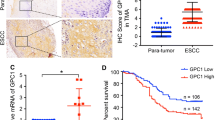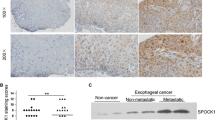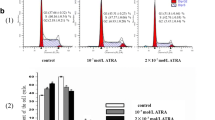Abstract
Background
Heparin-binding growth factor signaling is involved in the pathogenesis and development of human cancers. It can be regulated by sulfation of cell-surface heparan sulfate proteoglycans (HSPG). SULF1 is a heparin-degrading endosulfatase which can modulate the sulfation of HSPGs.
Aim
The purpose of this study was to elucidate the role of SULF1 in modulating proliferation and invasion of esophageal squamous cell carcinoma (ESCC) by decreasing heparin-binding growth factor signaling.
Methods
We restored SULF1 expression in the ESCC cell line KYSE150, and examined the effects of SULF1 expression on the proliferation and invasion of KYSE150 cells. In addition, we investigated the expression of SULF1 in human ESCC tissues and analyzed the correlation of SULF1 expression with clinicopathologic characteristics of ESCC.
Results
Our study shows that re-expression of SULF1 in ESCC cell line results in the downregulation of hepatocyte growth factor-mediated activation of MAPK pathways with a resultant decrease in cell invasiveness. Cell proliferation was also inhibited in SULF1-transfected KYSE150 cells. Immunohistochemical assays reveal that SULF1 is expressed in nearly half of the human ESCC tissues but not in normal esophageal epithelial cells. SULF1 expression in human ESCC tissues is negatively correlated with tumor size and tumor invasion.
Conclusion
This study identified that SULF1 inhibits proliferation and invasion of ESCC by decreasing heparin-binding growth factor signaling and suggested that SULF1 plays an inhibiting role in the pathogenesis of ESCC.





Similar content being viewed by others
References
Enzinger PC, Mayer RJ. Esophageal cancer. N Engl J Med. 2003;349:2241–2252.
Li JY. Epidemiology of esophageal cancer in China. Natl Cancer Inst Monogr. 1982;62:113–120.
Grugan KD, Miller CG, Yao Y, et al. Fibroblast-secreted hepatocyte growth factor plays a functional role in esophageal squamous cell carcinoma invasion. Proc Natl Acad Sci USA. 2010;107:11026–11031.
Noma K, Smalley KS, Lioni M, et al. The essential role of fibroblasts in esophageal squamous cell carcinoma-induced angiogenesis. Gastroenterology. 2008;134:1981–1993.
Selva EM, Perrimon N. Role of heparan sulfate proteoglycans in cell signaling and cancer. Adv Cancer Res. 2001;83:67–80.
Aviezer D, Levy E, Safran M, et al. Differential structural requirements of heparin and heparan sulfate proteoglycans that promote binding of basic fibroblast growth factor to its receptor. J Biol Chem. 1994;269:114–121.
Pye DA, Vives RR, Turnbull JE, Hyde P, Gallagher JT. Heparan sulfate oligosaccharides require 6-O-sulfation for promotion of basic fibroblast growth factor mitogenic activity. J Biol Chem. 1998;273:22936–22942.
Fernig DG, Chen HL, Rahmoune H, Descamps S, Boilly B, Hondermarck H. Differential regulation of FGF-1 and -2 mitogenic activity is related to their kinetics of binding to heparan sulfate in MDA-MB-231 human breast cancer cells. Biochem Biophys Res Commun. 2000;267:770–776.
Pye DA, Vives RR, Hyde P, Gallagher JT. Regulation of FGF-1 mitogenic activity by heparan sulfate oligosaccharides is dependent on specific structural features: differential requirements for the modulation of FGF-1 and FGF-2. Glycobiology. 2000;10:1183–1192.
Morimoto-Tomita M, Uchimura K, Werb Z, Hemmerich S, Rosen SD. Cloning and characterization of two extracellular heparin-degrading endosulfatases in mice and humans. J Biol Chem. 2002;277:49175–49185.
Viviano BL, Paine-Saunders S, Gasiunas N, Gallagher J, Saunders S. Domain-specific modification of heparan sulfate by Qsulf1 modulates the binding of the bone morphogenetic protein antagonist Noggin. J Biol Chem. 2004;279:5604–5611.
Ai X, Do AT, Lozynska O, Kusche-Gullberg M, Lindahl U, Emerson CP Jr. QSulf1 remodels the 6-O sulfation states of cell surface heparan sulfate proteoglycans to promote Wnt signaling. J Cell Biol. 2003;162:341–351.
Lai J, Chien J, Staub J, et al. Loss of HSulf-1 up-regulates heparin-binding growth factor signaling in cancer. J Biol Chem. 2003;278:23107–23117.
Lai JP, Chien JR, Moser DR, et al. hSulf1 sulfatase promotes apoptosis of hepatocellular cancer cells by decreasing heparin-binding growth factor signaling. Gastroenterology. 2004;126:231–248.
Narita K, Chien J, Mullany SA, et al. Loss of HSulf-1 expression enhances autocrine signaling mediated by amphiregulin in breast cancer. J Biol Chem. 2007;282:14413–14420.
Narita K, Staub J, Chien J, et al. HSulf-1 inhibits angiogenesis and tumorigenesis in vivo. Cancer Res. 2006;66:6025–6032.
Desiderio MA. Hepatocyte growth factor in invasive growth of carcinomas. Cell Mol Life Sci. 2007;64:1341–1354.
Porte H, Triboulet JP, Kotelevets L, et al. Overexpression of stromelysin-3, BM-40/SPARC, and MET genes in human esophageal carcinoma: implications for prognosis. Clin Cancer Res. 1998;4:1375–1382.
Ren Y, Cao B, Law S, et al. Hepatocyte growth factor promotes cancer cell migration and angiogenic factors expression: a prognostic marker of human esophageal squamous cell carcinomas. Clin Cancer Res. 2005;11:6190–6197.
Rubin JS, Day RM, Breckenridge D, et al. Dissociation of heparan sulfate and receptor binding domains of hepatocyte growth factor reveals that heparan sulfate-c-met interaction facilitates signaling. J Biol Chem. 2001;276:32977–32983.
Lyon M, Deakin JA, Mizuno K, Nakamura T, Gallagher JT. Interaction of hepatocyte growth factor with heparan sulfate. Elucidation of the major heparan sulfate structural determinants. J Biol Chem. 1994;269:11216–11223.
Lai JP, Chien J, Strome SE, et al. HSulf-1 modulates HGF-mediated tumor cell invasion and signaling in head and neck squamous carcinoma. Oncogene. 2004;23:1439–1447.
Rahman FB, Ishihara S, Aziz MM, Mishima Y, Oshima N, Li YY, et al. Heparin-binding EGF-like factor augments esophageal epithelial cell proliferation, migration and inhibits TRAIL-mediated apoptosis via EGFR/MAPK signaling. Scand J Gastroenterol. 2010;45:1350–1359.
Staub J, Chien J, Pan Y, et al. Epigenetic silencing of HSulf-1 in ovarian cancer: implications in chemoresistance. Oncogene. 2007;26:4969–4978.
Liu P, Khurana A, Rattan R, et al. Regulation of HSulf-1 expression by variant hepatic nuclear factor 1 in ovarian cancer. Cancer Res. 2009;69:4843–4850.
Chen Z, Fan JQ, Li J, et al. Promoter hypermethylation correlates with the Hsulf-1 silencing in human breast and gastric cancer. Int J Cancer. 2009;124:739–744.
Backen AC, Cole CL, Lau SC, et al. Heparan sulphate synthetic and editing enzymes in ovarian cancer. Br J Cancer. 2007;96:1544–1548.
Li J, Kleeff J, Abiatari I, et al. Enhanced levels of Hsulf-1 interfere with heparin-binding growth factor signaling in pancreatic cancer. Mol Cancer. 2005;4:14.
Wang W, Xue L, Wang P. Prognostic value of beta-catenin, c-myc, and cyclin D1 expressions in patients with esophageal squamous cell carcinoma. Med Oncol. 2011;28:163–169.
Acknowledgments
This work was supported by National Key Basic Research Program of China (2012CB526600), National Natural Science Foundation of China (81272447) and Beijing Municipal Science and Technology Commission (Z101100055610031).
Conflict of interest
None.
Author information
Authors and Affiliations
Corresponding author
Electronic Supplementary Material
Below is the link to the electronic supplementary material.
Rights and permissions
About this article
Cite this article
Liu, CT., Zhu, ST., Li, P. et al. SULF1 Inhibits Proliferation and Invasion of Esophageal Squamous Cell Carcinoma Cells by Decreasing Heparin-Binding Growth Factor Signaling. Dig Dis Sci 58, 1256–1263 (2013). https://doi.org/10.1007/s10620-012-2429-4
Received:
Accepted:
Published:
Issue Date:
DOI: https://doi.org/10.1007/s10620-012-2429-4




